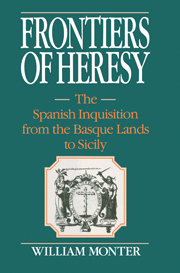Book contents
- Frontmatter
- Contents
- List of maps and figure
- List of tables
- Preface
- PART 1 THE HOLY OFFICE OUTSIDE CASTILE
- PART 2 ARAGONESE TRIBUNALS
- 4 Saragossa: a royal fortress
- 5 Barcelona: Inquisitors with short arms
- 6 Valencia: taming the magnates
- 7 Navarre: the four conspiracies
- 8 Sicily: Italian wine in Spanish bottles
- PART 3 ARAGONESE HERESIES
- PART 4 “MIXED CRIMES” IN ARAGON
- PART 5 RECESSIONAL
- APPENDICES
- Glossary
- Index
- CAMBRIDGE STUDIES IN EARLY MODERN HISTORY
8 - Sicily: Italian wine in Spanish bottles
Published online by Cambridge University Press: 24 October 2009
- Frontmatter
- Contents
- List of maps and figure
- List of tables
- Preface
- PART 1 THE HOLY OFFICE OUTSIDE CASTILE
- PART 2 ARAGONESE TRIBUNALS
- 4 Saragossa: a royal fortress
- 5 Barcelona: Inquisitors with short arms
- 6 Valencia: taming the magnates
- 7 Navarre: the four conspiracies
- 8 Sicily: Italian wine in Spanish bottles
- PART 3 ARAGONESE HERESIES
- PART 4 “MIXED CRIMES” IN ARAGON
- PART 5 RECESSIONAL
- APPENDICES
- Glossary
- Index
- CAMBRIDGE STUDIES IN EARLY MODERN HISTORY
Summary
Che cosa V.M. può sperare da un Regno con un populo di varie nazioni cristiane: mori, turchi, greci di levante,… pieno d'infedeli in tempi cosi calamatosi, di gente tanto lubrica? … La Sicilia, la terra che più bisognerebbe unire alia Spagna, non deve farsi una più grande Italia: basta la sua malvagità.
Inquisitor Haedo to Philip II, 1579 (quoted by Garufi, Fatti e personaggi, pp. 227–28, 231).En este isla mas facilmente se hallaran cien testigos para provar una mentira que dos para provar una verdad.
Archbishop of Cagliari, c. 1555 (quoted in Dionigi Scano, Sigismondo Arquer [Cagliari, 1933], p. 104, n. 1).At the end of the public auto de fe celebrated at the Sicilian capital of Palermo in December 1607, the cardboard effigy of a surgeon named Zosimo Cannata, who had died three years ago, was officially condemned. The Inquisition's notaries solemnly warned that all his descendants for four generations would be forbidden from holding any ecclesiastical benefices, forbidden to ride on horseback, forbidden to wear silk. On the morning after the auto, Cannata's effigy was burned outside the gate of St. Agatha by order of Palermo's Captain. Unlike the hundreds of people who shared his dubious honor of being executed in effigy by the Spanish Inquisition after 1540, Cannata was not a baptized Catholic accused of practicing Judaism, Protestantism, or Islam. What had he done to deserve this unusual distinction?
- Type
- Chapter
- Information
- Frontiers of HeresyThe Spanish Inquisition from the Basque Lands to Sicily, pp. 164 - 186Publisher: Cambridge University PressPrint publication year: 1990



